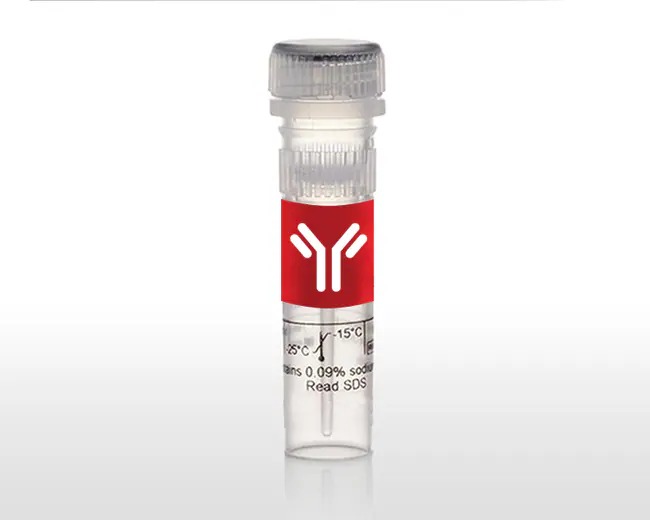Invitrogen™ Mouse IgG PARP1 Monoclonal Antibody (123), 100 µg
Catalog No :
CAS Number :
Brand :
In Stock
Specifications:
| Application | Western Blot, immunocytochemistry, Immunohistochemistry, Immunoprecipitation (IP) | ||
| Storage Temperature | -20°C | ||
| Product Type | antibody | Forms | Liquid |
| Product Brand | Thermo Fisher Scientific™, Invitrogen | ||
| Product Grade | Molecular Biology | ||
The Invitrogen™ Mouse IgG PARP1 Monoclonal Antibody (123) is a highly specific antibody designed to detect Poly (ADP-ribose) polymerase 1 (PARP1) in various biological samples. PARP1 is a key enzyme involved in the DNA repair process and apoptosis, and its cleavage is an early marker of programmed cell death (apoptosis). This antibody is conjugated to IgG1 from a mouse source, and it is ideal for applications such as Western blotting (WB), immunohistochemistry (IHC), immunocytochemistry (ICC/IF), flow cytometry (Flow), and immunoprecipitation (IP).
The Monoclonal Antibody 123 recognizes the full-length PARP1 protein and its cleaved fragments, which are important for studies on cell death mechanisms, cancer research, and neurodegenerative diseases.
Key Features:
-
Highly Specific Detection of PARP1:
- This antibody specifically recognizes PARP1, a critical protein in DNA repair and apoptosis studies.
-
Monoclonal Antibody:
- Mouse IgG1 monoclonal antibody, ensuring high specificity and consistency across experiments.
-
Broad Species Reactivity:
- Reactive to Human, Mouse, Pig, Rat, and other species, enabling cross-species studies.
-
Dilution Range:
- Western Blot (WB): 0.1-0.2 µg/mL
- Immunohistochemistry (IHC): 1:10-1:50
- Immunocytochemistry (ICC/IF): 1-2 µg/mL
- Immunoprecipitation (IP): 1:100-1:300
-
Purification:
- Purified by Protein A affinity chromatography, ensuring high purity and minimal non-specific binding.
-
Unconjugated:
- The antibody is unconjugated, offering flexibility for custom labeling and immunoassay setups.
-
Storage and Stability:
- Store at 4°C short term or -20°C long term to preserve antibody integrity.
-
CCCP Control for Assay Standardization:
- Includes CCCP (Mitochondrial Membrane Potential Disruptor) to control fluorescence compensation in experiments.
Specifications:
| Feature | Details |
|---|---|
| Host/Isotype | Mouse IgG1 |
| Species Reactivity | Human, Mouse, Pig, Rat |
| Dilution Range | WB: 0.1-0.2 µg/mL, IHC: 1:10-1:50, ICC/IF: 1-2 µg/mL, IP: 1:100-1:300 |
| Purification | Protein A affinity chromatography |
| Concentration | 0.5 mg/mL |
| Storage Buffer | PBS, 20% Glycerol, 1% BSA |
| Preservative | 0.1% Sodium Azide |
| Storage Conditions | 4°C short term, -20°C long term |
| Shipping Conditions | Ambient (domestic), Wet ice (international) |
Applications:
-
Apoptosis Studies:
- Detect cleaved PARP1 in apoptotic cells as an early marker of programmed cell death.
-
Western Blotting (WB):
- Identify cleaved PARP1 in protein lysates from cells undergoing apoptosis.
-
Immunohistochemistry (IHC):
- Label PARP1 in tissue sections, providing insights into apoptosis in diseased tissues.
-
Immunocytochemistry (ICC/IF):
- Monitor cleaved PARP1 in live or fixed cells for real-time apoptosis studies.
-
Immunoprecipitation (IP):
- Used for isolation of PARP1 protein complexes in apoptosis research and protein interaction studies.
-
Flow Cytometry (Flow):
- Used to quantify PARP1 cleavage in large populations of cells undergoing apoptosis.
Positive Control:
- HeLa cells, PC-12, Jurkat cells treated with Cisplatin or other apoptotic inducers.
Target Information:
Poly (ADP-ribose) polymerase 1 (PARP1) plays a pivotal role in DNA repair and apoptosis. During apoptosis, PARP1 undergoes proteolytic cleavage by caspases, resulting in the formation of an 85 kDa fragment, which is an early indicator of apoptosis. PARP1 is involved in the cleavage of amyloid-beta precursor proteins in neurodegenerative diseases like Alzheimer's disease.
The Invitrogen™ Caspase 3 Recombinant Rabbit Monoclonal Antibody (123) is a specific, recombinant monoclonal antibody designed for detecting cleaved PARP1 in apoptosis and cell death studies. With high sensitivity, purity, and flexibility, it is an essential tool for Western blot, immunohistochemistry, and immunocytochemistry assays in apoptosis research and drug testing.




 0
0
